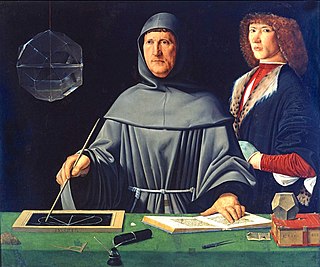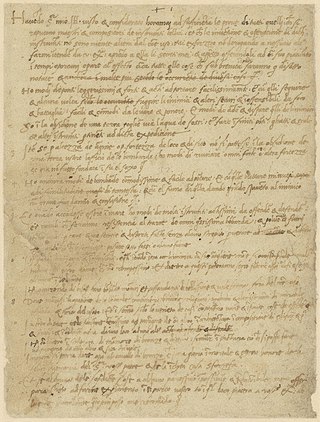Related Research Articles

Leonardo di ser Piero da Vinci was an Italian polymath of the High Renaissance who was active as a painter, draughtsman, engineer, scientist, theorist, sculptor, and architect. While his fame initially rested on his achievements as a painter, he also became known for his notebooks, in which he made drawings and notes on a variety of subjects, including anatomy, astronomy, botany, cartography, painting, and paleontology. Leonardo is widely regarded to have been a genius who epitomized the Renaissance humanist ideal, and his collective works comprise a contribution to later generations of artists matched only by that of his younger contemporary, Michelangelo.

Fra. Luca Bartolomeo de Pacioli was an Italian mathematician, Franciscan friar, collaborator with Leonardo da Vinci, and an early contributor to the field now known as accounting. He is referred to as the father of accounting and bookkeeping and he was the first person to publish a work on the double-entry system of book-keeping on the continent. He was also called Luca di Borgo after his birthplace, Borgo Sansepolcro, Tuscany.

The Mona Lisa is a half-length portrait painting by Italian artist Leonardo da Vinci.

The Vitruvian Man is a drawing by the Italian Renaissance artist and scientist Leonardo da Vinci, dated to c. 1490. Inspired by the writings of the ancient Roman architect Vitruvius, the drawing depicts a nude man in two superimposed positions with his arms and legs apart and inscribed in both a circle and square. Described by the art historian Carmen C. Bambach as "justly ranked among the all-time iconic images of Western civilization". Although not the only known drawing of a man inspired by the writings of Vitruvius, the work is a unique synthesis of artistic and scientific ideals and often considered an archetypal representation of the High Renaissance.

Martin John Kemp is a British art historian and exhibition curator who is one of the world's leading authorities on the life and works of Leonardo da Vinci. The author of many books on Leonardo, Kemp has also written about visualisation in art and science, particularly anatomy, natural sciences and optics. Instrumental in the controversial authentication of Salvator Mundi to Leonardo, Kemp has been vocal on attributions to Leonardo, including support of La Bella Principessa and opposition of the Isleworth Mona Lisa.

John Thomas Spike is an American art historian, curator, and author, specializing in the Italian Renaissance and Baroque periods. He is also a contemporary art critic and past director of the Florence Biennale.

Giovanni Antonio Boltraffio was an Italian painter of the High Renaissance from Lombardy, who worked in the studio of Leonardo da Vinci. Boltraffio and Bernardino Luini are the strongest artistic personalities to emerge from Leonardo's studio. According to Giorgio Vasari, he was of an aristocratic family and was born in Milan.

The Italian polymath Leonardo da Vinci (1452–1519) left thousands of pages of writings and drawings, but rarely made any references to his personal life. The resulting uncertainty, combined with mythologized anecdotes from his lifetime, has resulted in much speculation and interest in Leonardo's personal life. Particularly, his personal relationships, philosophy, religion, vegetarianism, left-handedness and appearance.

The Codex Atlanticus is a 12-volume, bound set of drawings and writings by Leonardo da Vinci, the largest single set. Its name indicates the large paper used to preserve original Leonardo notebook pages, which was used for atlases. It comprises 1,119 leaves dating from 1478 to 1519, the contents covering a great variety of subjects, from flight to weaponry to musical instruments and from mathematics to botany. This codex was gathered in the late 16th century by the sculptor Pompeo Leoni, who dismembered some of Leonardo's notebooks in its formation. It is now in the Biblioteca Ambrosiana in Milan.
Marvin Hayes is an American painter and illustrator, working primarily in egg tempera and copperplate etchings.

La Bella Principessa, also known as Portrait of Bianca Sforza, Young Girl in Profile in Renaissance Dress and Portrait of a Young Fiancée, is a portrait in coloured chalks and ink, on vellum, of a young lady in fashionable costume and hairstyle of a Milanese of the 1490s. Some scholars have attributed it to Leonardo da Vinci but the attribution and the work's authenticity have been disputed.

The portrait of a man in red chalk in the Royal Library of Turin is widely, though not universally, accepted as a self-portrait of Leonardo da Vinci. It is thought that Leonardo da Vinci drew this self-portrait at about the age of 60. The portrait has been extensively reproduced and has become an iconic representation of Leonardo as a polymath or "Renaissance Man". Despite this, some historians and scholars disagree as to the true identity of the sitter.

La Scapigliata is an unfinished painting generally attributed to the Italian High Renaissance artist Leonardo da Vinci, and dated c. 1506–1508. Painted in oil, umber, and white lead pigments on a small poplar wood panel, its attribution remains controversial, with several experts attributing the work to a pupil of Leonardo. The painting has been admired for its captivating beauty, mysterious demeanor, and mastery of sfumato.

Salvator Mundi is a painting attributed in whole or in part to the Italian High Renaissance artist Leonardo da Vinci, dated to c. 1499–1510. Long thought to be a copy of a lost original veiled with overpainting, it was rediscovered, restored, and included in a major exhibition of Leonardo's work at the National Gallery, London, in 2011–2012. Auction house Christie's stated just after selling the work in 2017 that most leading scholars consider it to be an original work by Leonardo, but this attribution has been disputed by other leading specialists, some of whom propose that he only contributed certain elements; and others who believe that the extensive damage prevents a definitive attribution.

Study for the Madonna of the Cat is a set of two drawings by Leonardo da Vinci on both sides of a sheet of paper 13 centimeters high and 9.4 centimeters wide. The two drawings were made in pen and brown ink, on a preparatory drawing in stylus, with a brown wash on the back. This is one of the six works of Leonardo da Vinci showing the Virgin and Child playing with a cat or carrying it. A mirror symmetry between the drawings of the two faces is visible by transparency. The Study for the Madonna of the Cat is currently held at the British Museum in London under inventory number 1856,0621.1. The creative and scientific processes underlying the drawing Madonna of the Cat have been discussed by many art historians, including Kenneth Clark, Martin Kemp, Carmen Bambach and Larry Feinberg.
Luke Syson is an English museum curator and art historian. Since 2019, he has been the director of the Fitzwilliam Museum at the University of Cambridge, prior to which he held positions at the British Museum (1991–2002), the Victoria and Albert Museum (2002–2003), the National Gallery (2003–2012) and the Metropolitan Museum of Art (2015–2019). In 2011 he curated the acclaimed Leonardo da Vinci exhibition at the National Gallery: Leonardo da Vinci: Painter at the Court of Milan, which included his pivotal role in the controversial authentication by the National Gallery of da Vinci's Salvator Mundi.

The Lost Leonardo is an internationally co-produced documentary film directed by Andreas Koefoed, released in 2021. It follows the discovery and successive sales of the painting the Salvator Mundi, allegedly a work by Leonardo da Vinci, an artist for whom there are only a few attributed works in existence. The film chronicles the dramatic increases in the painting's value from its original purchase in 2005 for $1,175 to its auction in 2017 for $450 million, when it became the most expensive artwork ever sold. The use of high-end artwork for hiding wealth, as well as the conflicts created by large commissions and other economic incentives, are explored in the film. It includes interviews with leading art experts and art critics on issues regarding the provenance and authenticity of the work.
Robert B. Simon is an American art historian and art dealer most known for rediscovering Leonado Da Vinci's picture, Salvator Mundi.

Leonardo da Vinci's Greatest Hits is a painting created by American artist Jean-Michel Basquiat in 1982.
References
- ↑ Povoledo 2008.
- ↑ "Meet the Staff | the Metropolitan Museum of Art". Archived from the original on November 14, 2019. Retrieved December 6, 2019.
- ↑ McDermon, Daniel (November 5, 2017). "How a Curator Attributed This Drawing to Michelangelo". The New York Times . ISSN 0362-4331.
- ↑ Cascone, Sarah (February 4, 2019). "The Curator of the Met's Celebrated Michelangelo Show Just Won the First $100,000 Vilcek Prize to Support Immigrant Achievement". Artnet News . Retrieved December 6, 2019.